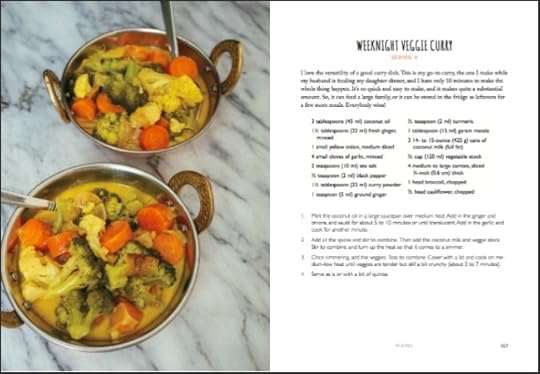Mark Sisson's Blog, page 154
February 7, 2018
Keto and Type 2 Diabetes
 If you think of Type 2 diabetes as carbohydrate intolerance, the natural dietary response should be to restrict the offending dietary component. And when this occurs—when diabetic patients restrict carbs—their symptoms improve, often to a greater degree than diabetic patients on other diets. Keto restricts more carbs than even other low-carb diets, so on the face of things, keto seems great for diabetes.
If you think of Type 2 diabetes as carbohydrate intolerance, the natural dietary response should be to restrict the offending dietary component. And when this occurs—when diabetic patients restrict carbs—their symptoms improve, often to a greater degree than diabetic patients on other diets. Keto restricts more carbs than even other low-carb diets, so on the face of things, keto seems great for diabetes.
Let’s take a closer look.
Common Features of Type 2 Diabetes
Insulin resistance: Your cells don’t respond as strongly to insulin, and you need more to produce the desired effect.
Hyperinsulinemia: Your insulin levels are always elevated. This inhibits you from releasing fatty acids from your body fat to be burned for energy.
Hyperglycemia: Because you’re not very good at using insulin to remove glucose from the blood, you often have high blood sugar—especially after eating. In fact, postprandial blood glucose is the most common way to diagnose type 2 diabetes.
Excess body fat: Gaining weight often leads to type 2 diabetes.
How Does Keto Affect Those Symptoms?
Insulin resistance: It depends. Keto can actually induce physiological insulin resistance, whereby the tissues become resistant to insulin so that the small amount of glucose you have in your blood is diverted to the areas of the brain that can’t use ketones. This is normal, not pathological, and doesn’t lead to hyperinsulinemia. If you’re losing weight on keto, your insulin sensitivity will improve.
Hyperinsulinemia: Keto lowers insulin levels. For ketosis to even occur, insulin must be low.
Hyperglycemia: It’s hard to spike blood sugar when you’re not eating carbs.
Excess body weight: Keto is an effective way to lose weight.
So far, so good. Theoretically, keto should work really well for people with type 2 diabetes. How does it work in real life folks with type 2 diabetes, though?
What Studies Tell Us
Study #1: Keto (No Control)
In 2005, researchers gathered 28 overweight patients with type 2 diabetes and placed them on a ketogenic diet with fewer than 20 g of carbs per day. Seven patients dropped out; 21 completed the 16 week study. Those who completed it had great results:
Body weight dropped by 6.6%, almost 20 pounds.
HbA1c dropped by 16%.
Triglycerides dropped by 42%.
Ten patients reduced their medications. Seven dropped them entirely. In only 16 weeks.
This was a pilot study without a control group, so it can’t be cited to directly compare keto to other diets. But it clearly worked.
Study #2: Low-Glycemic vs. Keto (Patients Who Were Obese and Had Type 2 Diabetes)
In another study, researchers directly compared keto to low-glycemic/carb. They took 84 obese patients with type 2 diabetes, randomly assigned them to either a ketogenic diet or a low-glycemic diet, and tracked their progress over 24 months. What happened?
Low-calorie group:
16% reduction in fasting glucose
6.9 kg bodyweight loss
0.5 reduction in HbA1c
Keto group:
20% reduction in fasting glucose
11.1 kg bodyweight loss
1.5 reduction in HbA1c
Both groups improved, but the keto group made bigger improvements, especially in HbA1c. Low-carb is good, keto might be better.
Study #3: Low-Calorie vs. Keto (Patients Who Were Obese)
Another study compared keto to low-calorie in obese patients, about a third of whom had diabetes. This time, the patients got to choose the diet that most appealed to them. So, it wasn’t random, but it was closer to how diets work in the real world.
Both groups improved markers of glucose control and metabolic health, but the keto group saw greater improvements on every single marker measured:
Blood lipids
Body weight
Waist circumference
HbA1c
Blood glucose
Uric acid
Urea
Creatinine
The drop in blood glucose in the keto dieters was intense enough that the researchers recommended anyone interested in trying it retain medical supervision.
In addition, only among the keto group were patients able to discontinue medications.
Study #4: Hypocaloric vs. Keto (Patients with Type 2 Diabetes)
In 2016, researchers ran a four month study comparing the effects of two diets in patients with type 2 diabetes. The first diet was your standard hypocaloric approach. The second was a very low carb ketogenic diet.
The keto group lost more body weight, more inches off their waist, and gained better control over their blood sugar. There were no adverse effects; kidney function remained stable throughout the study. Most importantly, the keto group had no trouble staying on the diet.
Standard Diabetic Education
Maybe you’re not convinced. Maybe you’re leaning toward meeting with the dietitian your doctor has recommended. That’s fine. Many medical professionals are waking up to the potential of the ketogenic diet, so you might actually hear similar advice. Just be aware of what else you might hear.
Let’s compare keto to how a Certified Diabetic Educator would feed the “average-sized” diabetic “trying to lose weight.”
45-60 grams of carbs per meal.
15-30 grams of carbs for snacks.
At three meals and two snacks a day, you’re looking at as many as 240 grams of carbohydrates for a person with diabetes who needs to lose some weight. If you follow the authority-sanctioned “expert.”
I read that and I’m completely blown away. It’s really that bad? That’s what your average type 2 diabetic who shows up at the doctor’s office with no clue about nutrition ends up eating? It’s probably even worse than that, because 60 grams of carbs easily turns into 70.
Perhaps that educator goes on to admit that keto is great for weight loss, has been shown to improve diabetic markers, and could even help prevent diabetes if you could “keep the weight off.” But it’s too hard, too restrictive for most people to follow, she’ll likely suggest.
She claims that the stress of watching how many carbs you eat will be “far more detrimental to your health” than going keto will be beneficial. I don’t actually disagree with that completely. If going keto is so stressful that your every waking moment is consumed by thoughts of carbs, and you can’t stick with the diet no matter how hard you try, maybe it’s not for you. That’s okay. I’ve never said everyone has to go keto, or even that everyone can go keto. Nor have I said that once you go keto, you can’t go back or rotate higher carb days into the routine.
So, good to go?
Mostly. Any medical patient should check with their doctor before changing their diet. You may have to adjust your medications (or remove them entirely). And keeping your doctor involved and apprised of your progress could legitimize the diet—if it works. Your doctor may even start recommending the diet to other patients.
Oh, and make sure you’re eating eggs, liver, or taking extra choline. Inadequate choline in the context of a high-fat diet can lead to hepatic fat accumulation, and a fatty liver increases insulin resistance and predicts the development of type 2 diabetes.
To sum up, going keto can be an effective dietary strategy for type 2 diabetes. All the available evidence suggests to me that, as a general guideline, it’s both safe and effective.
What about you? Anyone with type 2 diabetes try going keto? What were your results? And how has it influenced your work with your physician?
Thanks for reading, everyone. Take care!
The post Keto and Type 2 Diabetes appeared first on Mark's Daily Apple.



Midweek Quick Cooking: Turmeric Scrambled Eggs
 If a spice jar of turmeric has been sitting unused in your spice rack, here’s an idea: add a dash to scrambled eggs. It’s an easy way to add turmeric to your diet. If you want a double hit of turmeric, keep a nub of fresh turmeric root in the fridge, and grate a little over eggs once they’re cooked.
If a spice jar of turmeric has been sitting unused in your spice rack, here’s an idea: add a dash to scrambled eggs. It’s an easy way to add turmeric to your diet. If you want a double hit of turmeric, keep a nub of fresh turmeric root in the fridge, and grate a little over eggs once they’re cooked.
First, heat a tablespoon of fat in a small saucepan. Butter, ghee, and coconut oil are all great choices with turmeric, but if you haven’t tried red palm oil with scrambled eggs, give it a try. The heavy texture of red palm oil thickens the scramble, so it’s almost like eating an omelet. Plus, there’s something about the flavor of red palm oil that’s really great with eggs.
Once the oil is hot, add the powdered turmeric. Heating spices in fat is called “tempering,” and it’s a technique used often in Indian and Middle Eastern cuisines. Hot fat unlocks the flavor, aroma and healing properties of spices.
Start with just a dusting of turmeric, especially if you’re not used to the slightly bitter flavor (to mellow the flavor of turmeric in eggs, add a drizzle of coconut milk or whole cream, or grated cheese). Garnishes like green onion, fresh herbs and a hefty grind of black pepper are fantastic with turmeric. Black pepper doesn’t just taste good with the spice, it’s also necessary for absorbing curcumin, the primary constituent of turmeric with the health benefits.
Toast isn’t necessary, obviously, but turmeric scrambled eggs served on a slice of honey-sweetened Primal cornbread…it’s a delicious way to start the day.
Servings: 2
Time in the Kitchen: 10 minutes
Ingredients

4 eggs
2 tablespoon red palm oil, or other fat (30 ml)
¼ to ½ teaspoon ground turmeric (1.2 to 2.5 ml)
Black pepper and sea salt
Optional: Fresh turmeric root
Garnishes: Fresh herbs like cilantro, parsley, chives or dill, black pepper, green onion
Instructions

Whisk the eggs together in a bowl, or, for eggs with runny yolks and fully intact cholesterol, separate the whites and yolks into separate bowls and scramble the whites. Add a pinch of salt.
In a small saucepan over medium-low heat, warm the red palm oil. When the oil is hot, add powdered turmeric. Cook 20 seconds, stirring the turmeric into the oil.
Add the eggs (or, just the egg whites). Let the eggs cook undisturbed until the egg begins to set around the edges. Use a spatula to move and stir the eggs around the pan. If you’ve separated the whites and yolks, then add the yolks now and briefly scrambled.
When the eggs are just barely set, remove from the pan. Grate fresh turmeric root on top (optional). Sprinkle sea salt and black pepper over the eggs and garnish with fresh herbs, green onion.

Want more Primal recipes?
Try the Primal Blueprint Slow Cooker Cookbook for free here.
The post Midweek Quick Cooking: Turmeric Scrambled Eggs appeared first on Mark's Daily Apple.



February 6, 2018
Introducing Accidental Paleo: A Grain-Free, Meat-Free, Hassle-Free Cookbook!
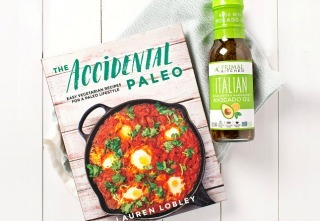 Today I’m excited to introduce a book that breaks new ground at Primal Publishing. It’s a book that reflects the growing expansion and diversity of the Primal/paleo movement: Accidental Paleo. Malibu’s own Lauren Lobley—a chef, caterer and private nutrition coach as well as host of the Delectable You YouTube show—runs with the truth that you can be a vegetarian and still adhere to Primal/paleo principles. Accidental Paleo is full of colorful, nutritious and creative recipes that are whole-food, meat-free, grain-free, and hassle-free. Whether you’re a Primal-minded vegetarian or a traditional Primal eater, the amazing recipes and food preparation tips of Accidental Paleo offer serious kitchen inspiration and solid Primal nutrition.
Today I’m excited to introduce a book that breaks new ground at Primal Publishing. It’s a book that reflects the growing expansion and diversity of the Primal/paleo movement: Accidental Paleo. Malibu’s own Lauren Lobley—a chef, caterer and private nutrition coach as well as host of the Delectable You YouTube show—runs with the truth that you can be a vegetarian and still adhere to Primal/paleo principles. Accidental Paleo is full of colorful, nutritious and creative recipes that are whole-food, meat-free, grain-free, and hassle-free. Whether you’re a Primal-minded vegetarian or a traditional Primal eater, the amazing recipes and food preparation tips of Accidental Paleo offer serious kitchen inspiration and solid Primal nutrition.
Lauren’s inspiration for this book came out of her own journey from sugar addict to healthy eater, a journey that didn’t involve meat. Many of her private nutrition consultation/catering clients expressed a similar desire to tone down the grains and sugars that promote excess insulin production without jumping into the steak and bacon scene.
Oftentimes, narrowing down one’s eating options to exclude grains and sugars as well as animal products can be a recipe for failure—many well-intentioned people just can’t deal with that level of restriction. You can only nibble on nuts and eat piles of steamed vegetables for so long before your eating routine becomes bland and boring. In Lauren’s case, her passion for cooking was the catalyst for a successful long-term dietary transformation.
This book will awaken you to the amazing versatility and endless possibilities of vegetable-centered meals. Even if you are a big fan of meat like me, this book will become a unique and indispensable addition to your recipe collections. Now that I spend a good deal of time eating with keto adaptation in mind, I actually do more with low carb vegetables, and Accidental Paleo has been an excellent inspiration for keeping things fresh. And my penchant for salads? I’ve loved the inspiration from ten different salad recipes—everything from Grilled Veggie Salad with Pesto to Kale Salad with Spicy Almond Dressing.
But salads are only the beginning. Accidental Paleo shows how meatless main meals and tempting sides can satisfy both a taste for rich flavors and Primal nutrient requirements. With recipes like Spinach-Artichoke Stuffed Portobello Mushrooms and Vegetarian Stuffed Peppers, it’s a feast for even carnivores can enjoy. (Note: Be sure to try the Dark Chocolate Raspberry Bars for dessert.) Simply put, this is the best of vegetarian eating on all counts. And as more people in the Primal/paleo realm embrace the benefits of plant-based meals—whether or not they include meat in their overall diet—Accidental Paleo is a fantastic resource for expanding Primal and paleo cooking and for enjoying great Primal-focused nutrition.
Now For the Deal…
Buy Accidental Paleo today on PrimalBlueprint.com, and I’ll throw in a FREE bottle of our brand new Primal Kitchen® Italian Vinaigrette. The latest addition to the Primal Kitchen dressing family is filled with fresh organic ingredients including thyme, basil, oregano, red wine vinegar, lemon juice, and sea salt. High in monounsaturated fats and infused with avocado oil, this plant-based dressing is the perfect complement to antipastos, fresh veggies, meat and fish marinades, and decadent salads. I think our Italian Vinaigrette and Lauren’s Cobley’s Accidental Paleo are the perfect pairing for delicious, plant-based Primal inspiration.
This deal only lasts through February 20, 2018, midnight PST, so don’t wait. Use code NEWITALIAN at checkout. Enjoy, everyone!
The post Introducing Accidental Paleo: A Grain-Free, Meat-Free, Hassle-Free Cookbook! appeared first on Mark's Daily Apple.



Primal Challenge: Forget the “Best” Workouts
 It’s one of the biggest mistakes people who are looking to reboot their health make—and one of the most common reasons so many are already dropping their New Year fitness goals. Anyone seeing the gyms clearing out yet? The optimist in me wishes they’ve simply found other pursuits outside the gym that interest them more—at home or in leagues or other venues. Experience, however, suggests differently.
It’s one of the biggest mistakes people who are looking to reboot their health make—and one of the most common reasons so many are already dropping their New Year fitness goals. Anyone seeing the gyms clearing out yet? The optimist in me wishes they’ve simply found other pursuits outside the gym that interest them more—at home or in leagues or other venues. Experience, however, suggests differently.
“Pursue the challenges that turn you on instead of worrying about what the magazines say is the ‘best’ workout, or the marketing hype that glorifies extreme events.” — The New Primal Blueprint, pg. 316
For more on finding your own fitness passions and creating an active lifestyle that fits your life, check out some of my past posts on the subject:
“How to Personalize Primal Blueprint Fitness”
Want to make fat loss easier?
Try the Definitive Guide for Troubleshooting Weight Loss for free here.
The post Primal Challenge: Forget the “Best” Workouts appeared first on Mark's Daily Apple.



February 5, 2018
Dear Mark: Women and Violence, Reducing Extra Wine, High Intensity Interval Resting, Phosphatidylserine and Mental Stress, Rethinking Stress
 For today’s edition of Dear Mark, I’m answering five questions from readers. First up, do my recommendations regarding violence and martial arts in last week’s “wildness post” also apply to women? Second, what else can you do with leftover wine? Next, how do I approach my rest and work cycles? Fourth, is phosphatidylserine good for mental stress or just physical stress? And last, does changing how we interpret or react to stress change its effects?
For today’s edition of Dear Mark, I’m answering five questions from readers. First up, do my recommendations regarding violence and martial arts in last week’s “wildness post” also apply to women? Second, what else can you do with leftover wine? Next, how do I approach my rest and work cycles? Fourth, is phosphatidylserine good for mental stress or just physical stress? And last, does changing how we interpret or react to stress change its effects?
Let’s go:
This post seemed mostly centered on men given they need more outlets for their violent/wild side. Do you think this pertains to women as well?
The post was definitely geared toward everyone—men and women, boys and girls, grandpas and grandmas. Everyone can benefit from climbing trees, creating a little more and consuming a little less, eliminating disorder in their home environment, and finding a tribe. I’d also argue that everyone can benefit from trying a martial art.
However, in general, men appear to have a higher appetite or “need” for violence.
It’s definitely true that most violent criminals are men, most homicides are committed by men (and most victims are men, too), and the average man has a higher predilection for violence than the average woman. There’s no getting around the hundreds of thousands of years of evolutionary pressure selecting for violence and aggression. It’s why in general men carry more muscle mass and physical strength than women—so they can throw harder punches and heavier spears.
But evolution didn’t select for murderous aggression. It selected for controlled aggression. For potential aggression. The ideal hunter or warrior is one who can mete out damage to others when required but avoids conflict when not. Someone who can protect their family and play with the baby.
Women may be less likely to have that predilection. Sure, the average woman is less interested in learning how to fight than the average man, but there are millions of outliers (in both sexes). Millions of women are interested in martial arts, and they should pursue that interest. I’d even argue that women who don’t think they’re into martial arts should give it a shot. They might be pleasantly surprised. Keep in mind, too, that it’s a physical art as well as a defense method.
The same goes for men, of course. If martial arts doesn’t interest you, it doesn’t interest you. But give it a shot before giving up.
Freezing wine. That is an amazing suggestion!
Another cool thing to do with leftover (or newly-opened—your choice) wine is to reduce it down to a few ounces and then freeze or store for later use. All the alcohol boils off and you can inundate a dish with intense wine flavors without needing to reduce the liquid so much.
Erin asked:
Should we concentrate on shoe-horning in anti-stress time every day, or can we get similar benefits from taking a “real” day off?
To me, there’s something to be said for treating your on and off days like you do your training.
On some projects, I dip in and out of work mode. I’ll work a few hours a day, get a hike in, maybe some paddling, and hop back on for a few more hours. This is how I do most blog posts and shorter-form writing.
Other projects require intense dedication, protracted focus. Deep work with long, infrequent breaks. I go hard and long. I’ll work for several days straight, then take a full day off—and I mean “off.” This is how I handle book and product launches.
It really depends on my intuition. I listen to my body. If I feel guilty about resting, I probably didn’t work hard enough. If I can flop down on the couch and watch Netflix without feeling an ounce of guilt, I probably need the time off. This assumes you’re in tune with your body and mind. I am—finally, after all these years!
Greg Harrington asked:
Does Phosphatidylserine help with mental-related stress? (i.e. stress about work, finances, relationships, etc.)
Yes. Several studies in humans show that PS helps in this area.
A 2004 found that low-moderate dose PS reduced the cortisol and adrenal response to induced stress. Higher doses did not have this affect, nor did the placebo.
Among men exposed to mental stress, those taking a PS supplement had higher cognitive function and a lower psychological stress response.
Among men with chronic stress, PS supplementation normalized their stress response.
The stuff is legit.
I’d like to know more about how the effects of stress are modified by how we think about or perceive stress.
Great insight. Our perception of stress is almost everything.
Try this:
Instead of worrying about your sweaty palms, pounding heart, anxiety, and nervous flutter in the stomach…
Embrace the fact that your body is increasing heart rate to boost blood flow and deliver more nutrients to your organs and tissues in preparation for the event. It’s prepping you physiologically and psychologically. It’s pumping you up. That flutter in the stomach? It’s so you don’t eat anything and divert energy toward digestion and away from focusing on your performance. That tunnel vision? It’s honing your attention to the matter at hand. Rapid breathing? That’s more oxygen for your brain. Your anxiety? You’re just being careful, paying attention to details, leaving nothing to chance.
I’m not making this up, either. There are empirical studies that show rethinking stress can change how it affects you psychologically and physiologically.
We sweat to alert others (via smell) to the stressful situation. Strength in numbers.
If you can rethink your approach to stress, you will benefit. People who think of the stress response as beneficial do not experience increased mortality due to stress.
When people learn to think of the stress response as psychological and physiological “preparedness,” many of the negative effects normally associated with stress vanish or are modified to be helpful. Their pulse rate quickens (normal), but their blood vessels expand rather than constrict. They have increased attentional bias (normal), but instead of focusing on the stress, they focus on the task at hand.
It’s not a simple matter to truly believe that the stress response is beneficial. You can’t snap your fingers and switch to a new mode of interpretation. But know that it’s not BS. That it increases preparedness for difficult tasks is the evolutionary reason why the stress response that arose arose. The stress response is adaptive. Know that, keep reminding yourself of that, and one day it’ll stick. Good luck.
Thanks for reading, everyone. Take care, leave your comments and input and questions down below, and have a great week!
Want to make fat loss easier?
Try the Definitive Guide for Troubleshooting Weight Loss for free here.
The post Dear Mark: Women and Violence, Reducing Extra Wine, High Intensity Interval Resting, Phosphatidylserine and Mental Stress, Rethinking Stress appeared first on Mark's Daily Apple.



Primal Reflection: Make a Transition Plan
 Having turned the calendar to February, it’s a good time to take stock. How did January go—and what do you want February to look like? What successful changes are you bringing away from the first month of 2018? More energy? A renewed optimism about your health? A new waist measurement? A more impressive mile time or VO2 max? A heftier deadlift max? Better sleep? Better confidence?
Having turned the calendar to February, it’s a good time to take stock. How did January go—and what do you want February to look like? What successful changes are you bringing away from the first month of 2018? More energy? A renewed optimism about your health? A new waist measurement? A more impressive mile time or VO2 max? A heftier deadlift max? Better sleep? Better confidence?
I hope you’ll share your successes (and your stumbling blocks) along the way. What worked for you? What didn’t? Did you follow the Action Items? What was most instrumental in the successes you experienced? And how will you carry it all over into this month? What will you do differently? What new supports will help you move through this next phase? No matter how dramatic or mixed the results, there’s so much to be gained from revisiting the overall venture. Reflection is an essential part of the process.
The post Primal Reflection: Make a Transition Plan appeared first on Mark's Daily Apple.



February 4, 2018
Weekend Link Love — Edition 489
 Research of the Week
Research of the WeekArchaeologists uncover evidence of extensive civilizational infrastructure in the Guatemalan jungle.
Subclinical magnesium deficiency is a likely driver of heart disease.
The modern human brain may be younger than previously thought.
High blood sugar linked to cognitive decline, even in the absence of type 2 diabetes.
New Primal Blueprint Podcasts

Episode 215: Ginny Cane: Host Elle Russ chats with Ginny Cane, who teaches people how to use Law of Attraction skills to get the life they want.
Keto Episode 216: Dr. Cate Shanahan #1: Brad Kearns and Dr. Lindsay Taylor chat with Dr. Cate about common keto misconceptions and myths.
Each week, select Mark’s Daily Apple blog posts are prepared as Primal Blueprint Podcasts. Need to catch up on reading, but don’t have the time? Prefer to listen to articles while on the go? Check out the new blog post podcasts below, and subscribe to the Primal Blueprint Podcast here so you never miss an episode.
Interesting Blog Posts
Is “Out of Africa” a theory in crisis?
Media, Schmedia
A 70% discount on Nutella has caused riots to erupt across France.
A Stanford researcher is working on a reset button for aging cells.
Everything Else
There’s no real evidence that the ancient Greeks reached America before any other Europeans, but it’s sure fun to consider.
Sounds like a pretty good f*cking read.
Maybe I should get these for my employees.
A familiar story, this time in Papua New Guinea: industrial diet replaces traditional diet with disastrous health consequences.
Things I’m Up to and Interested In
Hakas I enjoyed: This one and (especially) this one.
Another reason to check your apostrophe’s: It’ll affect your chance of getting into med school.
Good to see: Women surfers get a heat at Mavericks.
Concept I’m pondering: Does consciousness permeate everything?
I’m still not ready to retire: Depending on how you spend your free time, retirement could extend your life.
Recipe Corner
Make these honey sriracha shrimp bowls without the honey and you can probably stay keto.
A nice go-to vinaigrette.
Time Capsule
One year ago (Feb 4– Feb 10)
The Problem with Self-Improvement Culture (and What to Do About It) – Are you improving or do you just like reading about it?
20 Easy Bodyweight Exercises to Build Functional Arm Strength – 20 things you can do today to start getting stronger.
Comment of the Week
“The way HIV, zika and ebola hide, really takes balls!”
– Well said, Nocona.

The post Weekend Link Love — Edition 489 appeared first on Mark's Daily Apple.



February 3, 2018
Instant Pot Brisket with Potatoes
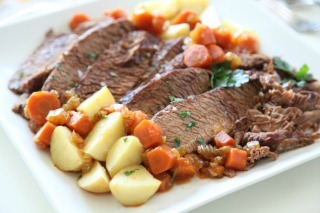 This recipe for Instant Pot brisket is comfort food at its best. No fancy ingredients or complicated instructions—just simple, perfectly cooked meat and potatoes. Potatoes are optional, though always delicious with brisket. In this recipe, the potatoes are pressure cooked then cooled in the refrigerator while the brisket cooks. Cooking potatoes in the Instant Pot takes less than 20 minutes and the texture is really nice. They don’t turn mushy or watery, like boiled potatoes sometimes do.
This recipe for Instant Pot brisket is comfort food at its best. No fancy ingredients or complicated instructions—just simple, perfectly cooked meat and potatoes. Potatoes are optional, though always delicious with brisket. In this recipe, the potatoes are pressure cooked then cooled in the refrigerator while the brisket cooks. Cooking potatoes in the Instant Pot takes less than 20 minutes and the texture is really nice. They don’t turn mushy or watery, like boiled potatoes sometimes do.
Cooling the potatoes increases the resistant starch, a special type of prebiotic that can be beneficial. Once the potatoes are cooled, you have several options: gently reheat the potatoes and top with butter and fresh herbs, sauté the potatoes in the fat of your choice until crispy, or make potato salad.
If potatoes aren’t your thing, that’s fine. Brisket is tasty with any type of roasted root vegetables, or greens sautéed in oil and garlic, or mashed cauliflower.
Consider making this entire recipe the day before it’s eaten. Brisket improves in flavor and texture when it rests for a day. If the brisket isn’t as tender as you’d like, then 24 hours in the fridge and a slow reheat in the oven is often the answer.
Servings: 6
Time in the Kitchen: 1 hour hands-on, plus 2 hours of Instant Pot cooking
Ingredients
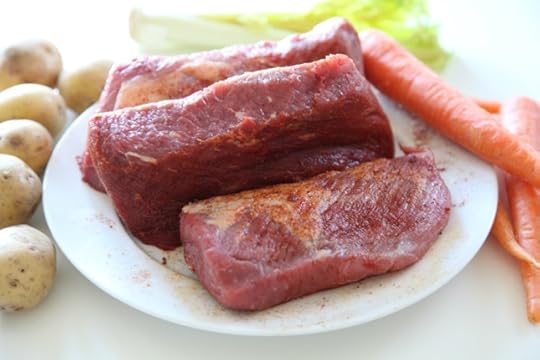
24 ounces Yukon gold potatoes, cut into 3/4-inch cubes (peeled or unpeeled) (680 g)
3 to 4 pounds brisket, cut into 3 pieces (1.8 to 2.3 kg)
2 ½ teaspoons kosher salt (12 ml)
1 teaspoon smoked paprika (5 ml)
2 tablespoons avocado oil (30 ml)
1 onion, chopped
4 garlic cloves, thinly sliced or chopped
4 carrots, peeled and cut into 1-inch rounds
2 stalks celery, sliced
1 ½ cup beef bone broth (350 ml)
4 sprigs thyme
Instructions

Recipe Note: Brisket with a nice layer of fat on top and some marbling throughout will be more juicy and flavorful and less prone to drying out. Unfortunately, most brisket is sold with the fat completely trimmed off. You might have to special order a “second cut” brisket with more fat. Chuck roast can also be substituted for brisket in this recipe.
Rub brisket with salt and smoked paprika, ideally 1 hour ahead of time. Set brisket out on the counter to come up to room temperature.
After the brisket is salted, cook the potatoes. Pour ¾ cup water into the pot of the electric pressure cooker (such as an Instant Pot). Add potatoes into the pot on a cooking insert or steamer insert.
Press manual and program the pressure cooker for 5 minutes at high pressure (valve in sealed position). Let the pressure release manually for 12 minutes, and then release the valve.
Transfer the potatoes to the refrigerator to cool. Pour the water out of the pressure cooker; rinse and dry the pot.
Set electric pressure cooker to sauté. Add avocado oil. When hot, add pieces of the brisket in batches and sear until browned, about 3 minutes per side. Add more oil or turn down heat as needed if the bottom of the pot begins to burn. Transfer brisket to a plate.
Add onion and celery. Sauté 3 to 5 minutes, adding more oil if needed. Add garlic. Sauté 1 minute more. Add carrots, bone broth, and thyme. Use a wooden spoon or spatula to scrape up any bits stuck to the bottom of the pot. Add brisket back to the pot.
Cover and cook on high pressure for 80 minutes (valve in sealed position). Let the pressure release naturally for about 20 minutes, then release.
Transfer the meat to a cutting board or plate. Let rest at least 15 minutes before slicing against the grain. The brisket can also be cooled completely and refrigerated overnight, then sliced and reheated in the oven, covered with foil, at 300 ºF/149 ºC until heated through.
The flavorful liquid left in the pot is delicious spooned over the brisket. For a less fatty sauce, refrigerate the liquid then scrape off the fat on top before reheating and serving.

The post Instant Pot Brisket with Potatoes appeared first on Mark's Daily Apple.



February 2, 2018
We Want To Share Your Stories (with a Giveaway)
 Success stories will be back in their regular slot next Friday, but for today I want to issue an invitation. Now that we’ve turned the corner on the first month of the year, I know some of you have already seen big success with living Primal and/or going keto. And I’d love to share your stories—to help inspire others here and to offer the kind of varied and personal accounts that only reader experiences can. Will you join the hundreds of others who have helped along the way?
Success stories will be back in their regular slot next Friday, but for today I want to issue an invitation. Now that we’ve turned the corner on the first month of the year, I know some of you have already seen big success with living Primal and/or going keto. And I’d love to share your stories—to help inspire others here and to offer the kind of varied and personal accounts that only reader experiences can. Will you join the hundreds of others who have helped along the way?
Over the years I’ve heard time and again about folks finally taking the plunge because of a story that touched them personally. Maybe they had the information, knew the Primal laws, had read the blog for weeks or months even, but another reader’s account of their journey brought it all home for them. The difficulties that person started with and the amazing transformation that resulted—this was a story they were somehow meant to read. It was what reached them—and put them on their own path to renewed health, more vitality, and a better life.
The fact is, when you share your own story, you never know who you’ll be helping. And that’s an awesome thing.
I’ll add that it doesn’t matter if you’ve reached your ultimate goals yet or are still on your way. If you’re feeling better, eating better, moving better, sleeping better and just living better, that’s what inspires people. I bet there are a whole lot of folks hesitating on the sidelines wondering if they can do this who would love to hear from someone who hasn’t necessarily reached their goal but is on their way—someone who’s a month or two in who can show them that the beginning isn’t as hard as they fear it will be. And that the benefits come sooner than they dare imagine.
Likewise, if you’re someone who went Primal years ago (and even submitted an earlier success story) but continue to live a better life than you dreamed because of the changes you made long ago—we want to hear how you’ve stayed the course, what adjustments you’ve found helpful, what long-term lessons have surfaced over the years. There’s nothing quite like a great update.
So, let me offer an incentive to kick us off….
The Giveaway
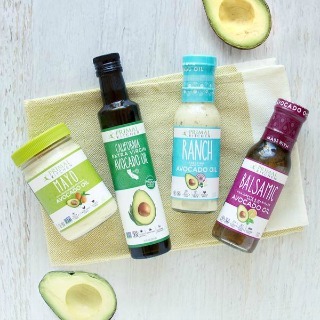 Anyone who sends me their success story along with photos will be entered to win a year’s supply of Primal Kitchen® Keto Kits—a shipment each month for the next 12 months. That’s 12 month’s worth of Primal Kitchen Mayo, Ranch Dressing, Balsamic Vinaigrette, and California Extra Virgin Avocado Oil.
Anyone who sends me their success story along with photos will be entered to win a year’s supply of Primal Kitchen® Keto Kits—a shipment each month for the next 12 months. That’s 12 month’s worth of Primal Kitchen Mayo, Ranch Dressing, Balsamic Vinaigrette, and California Extra Virgin Avocado Oil.
I’m sure many of you have thought about sending your story in but just haven’t gotten around to it. There is no better time than now.
Write it up and include a few photos—the more the merrier, the bigger the better (since it’s easier to format for the site that way). Including both pre-Primal and post-Primal pics is even better, but isn’t required.
Don’t worry if you’re not a chiseled Adonis. This isn’t a “who’s the most ripped” competition. No matter where you’re at in your transformation, tell me what going Primal has done for you so far.
I’m looking for interesting and personal tales. Details about your health history, how you found MDA and the Primal Blueprint, what has worked and what hasn’t, what differences you’ve seen in how you look and feel, and anything else you think readers might be able to learn from and you’re open to sharing are welcome. It doesn’t have to be a 3000-word essay, but it’s hopefully more than a few paragraphs. Feel free to be creative with your story format, too. Still, remember, good stories usually have a beginning, a middle, and an end—and honesty is king.
Check out other Success Stories here for ideas on how to write your own story.
Email me your story along with pictures. Please use the subject heading “My Primal Story.” Otherwise, there’s a good chance we might miss your submission.
Eligibility:
Anyone in the world can enter.
Additionally, everyone who has submitted a Success Story to Mark’s Daily Apple in the past is free to submit an updated story and new photos.
The Deadline:
Friday, February 16th, 2018, midnight PST
How the Winner Will Be Determined:
My staff and I determine which stories and accompanying photos get published on MDA. The winner of the giveaway will be chosen at random from those that are submitted by the deadline.
Thanks, everybody. I’m excited to read what you send—and to share it with our MDA audience. Have a great weekend.
The post We Want To Share Your Stories (with a Giveaway) appeared first on Mark's Daily Apple.



Don’t Miss This Keto f(x) Talk!
 Mark your calendars! Host of the Primal Blueprint Podcast host and author of The Paleo Thyroid Solution, our very own Elle Russ, is speaking at Keto f(x)™ on Monday, February 5th. Elle’s session is “Your Thyroid on Paleo-Keto” (a topic I know many here are interested in). She’ll share little known truths about thyroid health, and how a keto diet interacts with it.
Mark your calendars! Host of the Primal Blueprint Podcast host and author of The Paleo Thyroid Solution, our very own Elle Russ, is speaking at Keto f(x)™ on Monday, February 5th. Elle’s session is “Your Thyroid on Paleo-Keto” (a topic I know many here are interested in). She’ll share little known truths about thyroid health, and how a keto diet interacts with it.
For more on what she’ll cover, check out her Facebook live discussion with Keto f(x)™ host, Keith Norris, also co-founder of Paleo f(x)™ and biohacker with a passion for bettering lives by teaching the art and science of physical culture.
Keto f(x)™ is bringing together leading doctors, scientists and biohacking experts in the ketogenic diet. You will hear from 17 leaders over 10 days about the latest science and how to apply and optimize keto for stronger metabolism, brain and gut function, healthier thyroid and adrenal function, and more.
The event is FREE and online from January 29 – February 9, 2018! Get your free ticket today by registering HERE.
Want to make fat loss easier?
Try the Definitive Guide for Troubleshooting Weight Loss for free here.
The post Don’t Miss This Keto f(x) Talk! appeared first on Mark's Daily Apple.



Mark Sisson's Blog
- Mark Sisson's profile
- 199 followers



